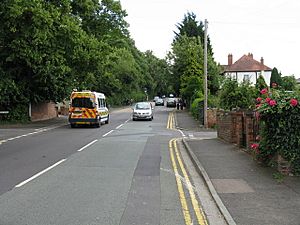Red Hill, Worcester facts for kids
Red Hill is an area in the city of Worcester, Worcestershire, England. You can find it in the south-east part of the city, right along the A44. For a long time, Red Hill has been an important place because it's high ground. This made it useful for defending or attacking the city. It was also a place where people faced punishment.
Contents
A Look Back at Red Hill
Red Hill has a long and interesting history, going back many centuries. It played a part in important events that shaped the area.
Early Battles and Forts
One of the earliest mentions of Red Hill is from the year 1149. This was when King Stephen attacked the city of Worcester. He burned parts of the city and forced out a local leader named William de Beauchamp.
King Stephen built two forts on Red Hill to help him attack Worcester Castle. However, the castle was very strong and resisted his attacks. People in 1820 could still see what they believed were the remains of these old forts.
Red Hill and the Gunpowder Plot
In the 1600s, Red Hill became known as a place where people were punished for serious crimes. On April 7, 1606, several people were executed here. Among them were Edward Oldcorne and Ralph Ashley, who had been captured nearby.
These individuals, along with a farmer named Perkes, Humphrey Littleton, and John Wintour, were all involved in the famous Gunpowder Plot. This was a plan to blow up the Houses of Parliament in London.
The Battle of Worcester
Red Hill was also important during the Battle of Worcester in 1651. This was a major battle in the English Civil War. Forces loyal to the King (called Royalists) fought against the army of Oliver Cromwell.
On August 29, 1651, Cromwell used the high ground of Red Hill and Perry Wood. He placed his cannons and most of his soldiers there. At that time, Red Hill was just outside the city walls. The Royalist forces tried to attack Cromwell's cannons but were stopped. This was partly because a spy from Worcester named Guise had given information to Cromwell's side. Guise was later caught and punished.
Later Punishments at Red Hill
Red Hill continued to be a place for executions for some time after the Civil War. For example, records show that on August 16, 1805, a person named W. Dalton was executed there. This was for two cases of burglary.


